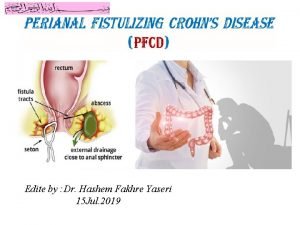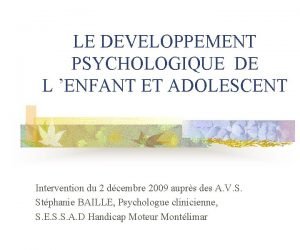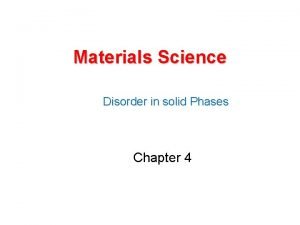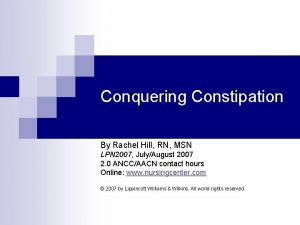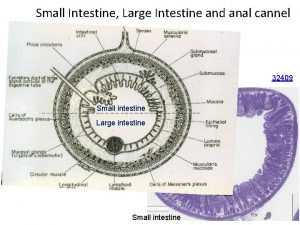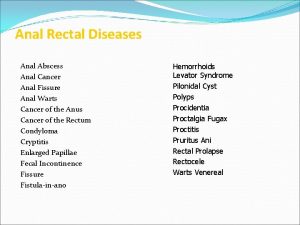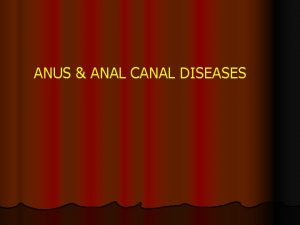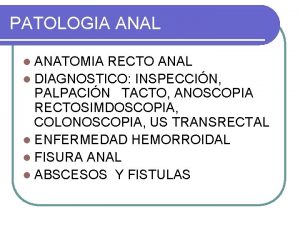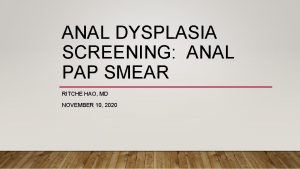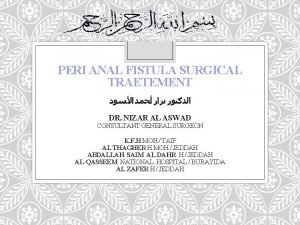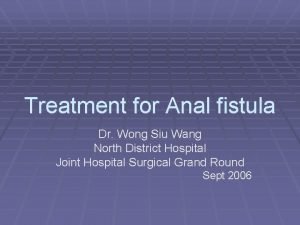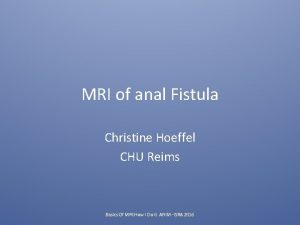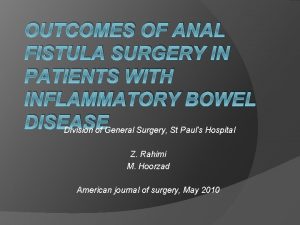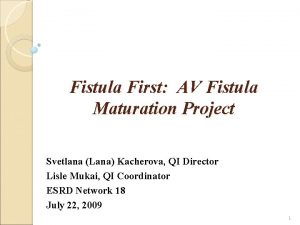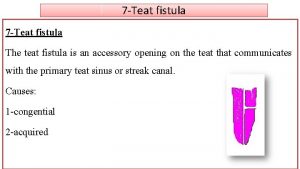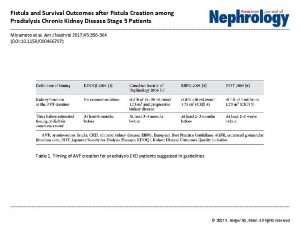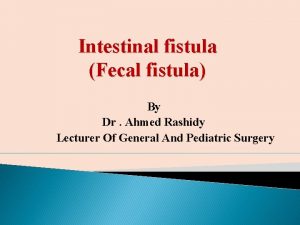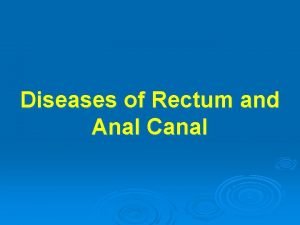Anal Fistula What are the causes of fistula





















- Slides: 21

Anal Fistula • What are the causes of fistula and what is Eisenhammer's theory? • What is Park's classification of anal fistula? • What are the options for managing fistula?

Why do we care? • Anal abscesses and fistulas are a common surgical problem • The majority share a common pathophysiology (primary cryptoglandular infection) but the resulting pathology is highly variable in the complexity with which the sphincter is involved 1 – Simplest = infection of anal gland perianal abscess that resolves after simple incision and drainage – Complex = suprasphincteric fistula with multiple tracks and cavities • No single procedure that reliably results in a high cure rate whilst preserving sphincter function 1

ANATOMY • External sphincter (ES) is a continuation of pelvic floor musculature 2 • Internal sphincter (IS) is a continuation of the inner circular muscle layer of the lower rectum 2 • Dentate line = site of anal valves • Proximal to each anal valve is a an anal crypt or sinus, anal glands empty into these crypts

AETIOLOGY • Cryptoglandular theory of Eisenhammer and Parks is widely accepted • Eisenhammer 3 – All non-specific abscess and fistulas are the result of extension of sepsis from an intramuscular gland, the sepsis being unable to drain spontaneously into the anal lumen because of infective obstruction of its connecting duct across the IS • Parks 4 – Should the initial abscess subside, the disease gland may become the seat of chronic infection with fistula formation

AETIOLOGY • Spread of sepsis can occur in 3 directions and circumferentially in any of the 3 planes From Companion Series, originally from Parks et al.

CLASSIFICATION OF ANAL FISTULA • The most widely used and taught is that devised by Sir Alan Parks at St Marks’ based on a study of 400 fistulas treated there • Crypotglandular hypothesis is central • Majority of fistulas arise from an abscess in the IS plane • The relationship of the primary track to the ES is paramount in surgical management and 4 main groups exist • • Intersphincteric Trans-sphincteric Suprasphincteric Extrasphincteric

ANORECTAL ABSCESS • Presentation – Local pain and swelling – Features depend on site • Management – Surgical drainage under GA (technique depends on location of abscess), incision parallel to the anal canal (less likely to cut through fibres of the ES)2 • Should we look for an internal opening at time of drainage? • Prevelance of fistula formation after drainage of abscess is ~30%2

ASSESSMENT OF ANAL FISTULA • Goodsall and Miles outlined 5 essential points in the assessment of fistulas in 19005 1) 2) 3) 4) 5) Location of the internal opening (IO) Location of the external opening (EO) Course of the primary track Presence of secondary extensions Presence of other diseases complication the fistula

ASSESSMENT OF ANAL FISTULA • Relative positions of IO and EO will indicate the likely course of the primary track • Presence of any palpable induration should alert you to a possible secondary track • Distance of EO from anal verge may assist in differentiating intersphincteric vs transsphincteric (greater distance = greater chance of complex cephalad extension)

Goodsall’s Rule

Clinical Assessment • External opening is usually clear (at site of previous or spontaneous drainage) • Track may be felt between finger and thumb on DRE (note any clinical abnormalities of the anal sphincter) • If no abscess formation requiring drainage, further assessment with EUS or EUA 2

Imaging • Endo-Anal Ultrasound – Cheap, “relatively easy” – Allows assessment of internal and external sphincter integrity – Operator dependent, limited focal range • MRI – Not cheap – No ionising radiation, able to image in any plane, high softtissue resolution – Very useful in Crohn’s • Fistulography – Inaccurate, unreliable, possible harmful

Other Investigations • Manometry – Assess sphincter function • EUA

TREATMENT OF ANAL FISTULA • Objectives of management (Finlay 6) – Define anatomy of fistula – Drain associated sepsis – Eradicate fistula track – Prevent recurrence – Preserve continence and sphincter integrity

Lay-Open (Fistulotomy) • Best treatment in terms of absolute cure • Very high fistulas SHOULD NOT be laid open • Very low fistulas can be laid open without functional sequelae • Low and mid trans-sphincteric, what to do?

Fistulotomy • • • Lithotomy, Park anal or Hill-Ferguson retractor Define track with blunt-ended probe Tissue along probe is divided along entire length Track curetted Haemostasis • Recurrence 0 -9%, disturbance in continence 033%

Seton • Thin silastic tubing or monofilament nonabsorbable nylon placed in track • “Holding position” to control sepsis while anatomy is investigated 1 • Loose seton doesn’t ususally lead to permanent healing 1 • Cutting seton creates a slow fistulotomy where there is sufficient time for fibrosis to prevent a defect in the sphincter (low recurrence, high reported incidence of incontinence)1 • Can be used long-term, preferred option in Crohn’s and recurrent fistulas

Advancement Flap • Only consider if a fistula cannot be laid open • Only when all sepsis has resolved • “Rectal advancement flap” – Full thickness flaps including mucosa and circular smooth muscle sutured over internal opening • Success rate varies 29 -95% (realistic 60 -70%) • Incontinence rates seem to be low

Fibrin Plug • Filling of the fistula track with a biological substance to encourage healing using fibrin glue of biological mesh • Encouraging results initially, long-term results not as encouraging

Conclusion “Given the variability in the nature of fisulae, it is likely that no single procedure will be appropriate for all cases” 1 • Most abscesses need to be drained • Most fistulas can be safely laid open without disturbance of continence – Usually clinically evident whether or not laying open is appropriate • “Mid level” fistulas should have radiological assessment of sphincter involvement • When multiple attempts have failed, a long-term seton may be the best option

References 1 The Authors Journal Compilation 2010 RACS 2 Rickard 3 S. Eisenhammer: The internal anal sphincter and the anorectal abscess. Surg Gynecol Obstet. 103, 1956, 501 4 Parks AG. The pathogenesis and treatment of fistula-in-ano. Br Med J; i: 463 -9 5 Goodsall DH, Miles WE. Diseases of the Anus and Rectum. London: Longman, 1900
 Antigentest åre
Antigentest åre Fistula in ano
Fistula in ano Anal fistula
Anal fistula Social behavior examples in animals
Social behavior examples in animals Proximate cause and ultimate cause
Proximate cause and ultimate cause Gezwungen anal
Gezwungen anal Periode de latence
Periode de latence Nothing is
Nothing is Phallic fixation
Phallic fixation Anal fixation
Anal fixation Industry vs. inferiority
Industry vs. inferiority Rachel hill anal
Rachel hill anal Crypts of lieberkuhn
Crypts of lieberkuhn Nishan
Nishan Anal sex survey
Anal sex survey Nick fox sex
Nick fox sex Barlow ortolani
Barlow ortolani Esfíncter
Esfíncter Etapa oral ejemplos
Etapa oral ejemplos Phallic stage of development
Phallic stage of development Anal varices
Anal varices Erogenous zone freud
Erogenous zone freud

